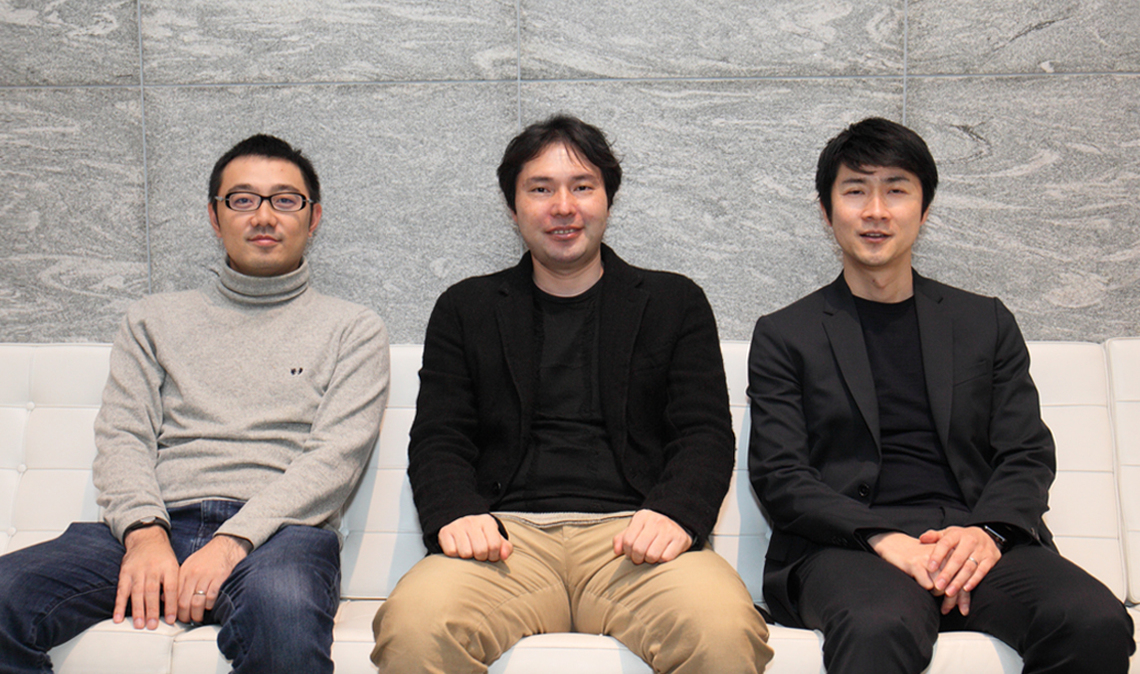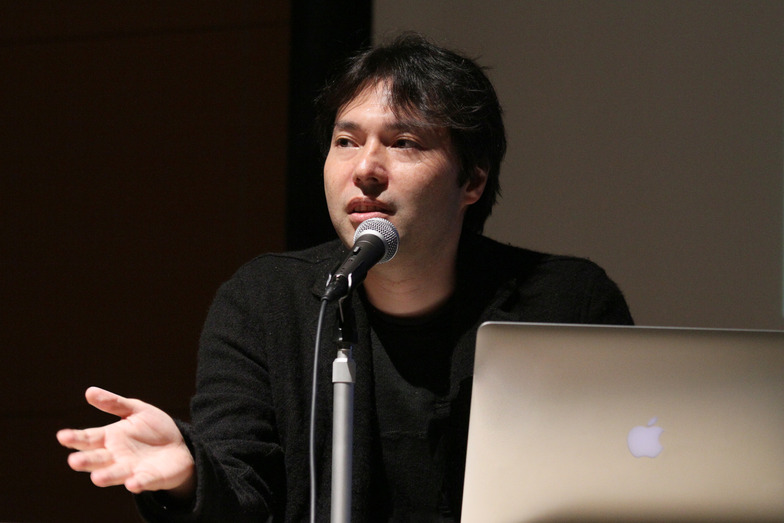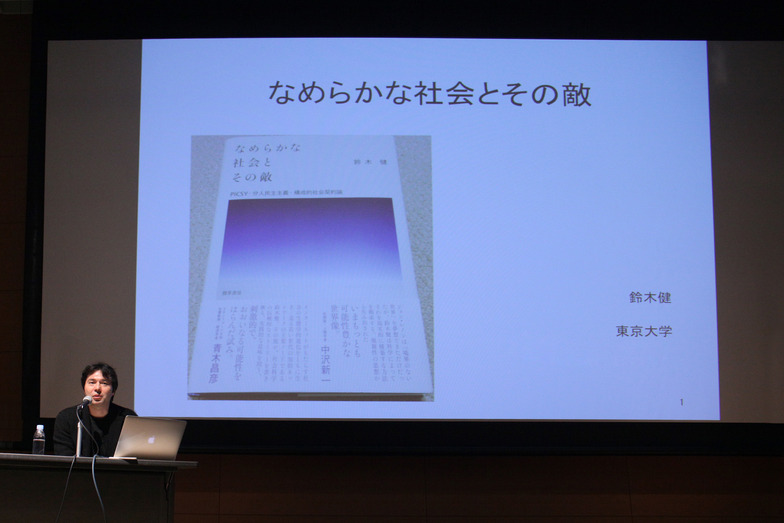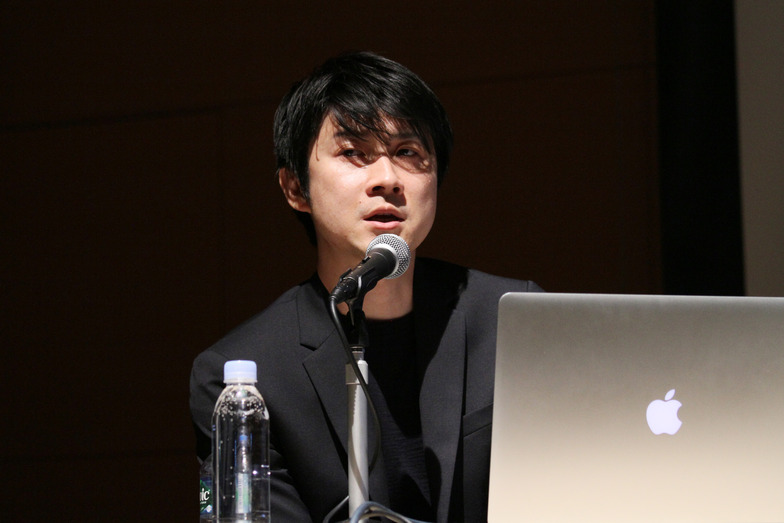Ken Suzuki is the co-founder of the Japan-U.S.-based news app " SmartNews." His book, "The Smooth Society and Its Enemies," explores the potential for ecological evolution of humans and society within the increasingly complex information society born after the internet. It has garnered significant attention alongside the rapid expansion and success of "SmartNews." Suzuki, Kinya Tagawa of takram, and Yohei Sadoshima of Cork share overlapping interests in major themes like programming and art, content and new distribution models, and business development processes, and have been in ongoing dialogue. This series presents Part 1 focusing on Suzuki's work and philosophy, followed by Part 2 featuring a discussion among the three on their respective "definitions of content and how to create it."

(From left) Mr. Sadojima, Mr. Suzuki, Mr. Tagawa
The Researcher Behind " SmartNews"
The Philosophy of Researcher Ken Suzuki
Sadojima: Today, as an editor, I'll be facilitating the discussion to draw out insights from both of you. First, Mr. Suzuki, could you share the philosophy behind the rapidly growing "SmartNews"?
Suzuki: My activities fall into two main categories. One is research in academic settings, and the other is building businesses. These two drive my work like a double helix.
My book published in January 2013, 'The Smooth Society and Its Enemies', though an academic work, was fortunately read by the general public and achieved an unusual print run of 12,000 copies. It explores designing a social system for 300 years hence using the internet. It compiles 13 years of research and thought, including concepts like a new monetary system where "value propagates."
In graduate school, I researched artificial life, using computers to create life phenomena. Through this research, I realized that social systems are also part of the evolution of life systems.
For example, single-celled organisms, though mechanically simple, possess a cognitive system for finding food, ingesting what they need to sustain themselves. Couldn't this behavior of single cells be the biological origin of private ownership as we practice it in society? Humans are multicellular organisms composed of 60 trillion cells. Each individual cell maintains its internal cellular system by using its cell membrane to prevent external substances from entering and to metabolize and expel waste. In other words, we maintain our own structure through such "membranes."
Thus, I came to think that societal ownership and national borders, traced back, might originate from cells. If so, all societal problems ultimately converge on how we design the tools, architecture, clothing, environment... all the creations and interactions surrounding life.

Alan Kay, often called the father of the personal computer, proposed the concept of "metamedia." In previous eras, media were relatively fixed, and the key issue was what content circulated on them. Just as the invention of movable type ushered in an era where the power of the pen shaped society. However, Alan Kay foresaw an era where anyone could create the media itself. His vision was a world where, over 300 years, everyone became a programmer—someone who could create media. If everyone in the world could read and write, the world would change. But what if everyone in the world started creating new media? That was his challenge, and to meet it, he invented "object-oriented languages"—programming languages even children could write.
When I contemplated what work I should pursue with such a society in mind, I decided I wanted to create services and media myself. My vision of a "smooth society" is a world that thoroughly embraces diversity. It's not about neatly dividing things into 0 or 1, like male or female, French or American, but about recognizing and enriching the space in between. There are many huge barriers standing in the way of realizing such a smooth society. In my book, 'Smooth Society and Its Enemies', I wrote about new social systems using information technology to break down those barriers. That's what I've done as research activity.

Meanwhile, I repeatedly took leaves of absence from graduate school to start ventures, launching SmartNews three years ago (2012). We started it with genius engineer Kaisei Hamamoto, and now have nearly 50 members in Japan and 10 in the US. Our mission is to deliver quality information worldwide. There are many media outlets creating excellent content, yet it often goes unread. That was our core problem statement.
Downloads have exceeded 15 million, with approximately 5 million monthly active users in Japan. What's particularly noteworthy is that in both Japan and the US, our total monthly visit time far outpaces other news apps. We take pride in this result, achieved by focusing our efforts on delivering compelling content.
SmartNews has no editorial department. Every article is selected by an algorithm. This algorithm is based on collective intelligence. While algorithms typically lean toward personalization, SmartNews delivers "news that offers you discovery," not just "news you're interested in." Our approach is: "We deliver it because it might offer you discovery, even if you might not be interested."
At its core lies the philosophy of delivering diverse content and diverse values to users. Today, the proliferation of social media has created filter bubble phenomena. Essentially, people only read what aligns with their existing interests. However, failing to encounter perspectives different from one's own can, in a sense, undermine the very foundation of democracy. While what SmartNews does is small, we aim to foster a society where as many people as possible can embrace the existence of different viewpoints and ways of thinking.
People who do unclear work
will shape the next era
Sadoshima: When you decided to launch your own service, why did you choose "news," Mr. Suzuki?
Suzuki: My initial idea was a monetary system where value propagates. Like how remixing ideas creates new content, this system would allow value to spread like investments. Eventually, I realized this could also be applied to information distribution.
Inspired by the SNS platforms emerging around 2004, I first launched "Social Trust Network," an RSS reader where information propagated across social networks. It recommended content that people with high affinity to you were interested in. Looking back, it was like Twitter's retweet function but automated—just a bit too early.
After that, I kept thinking about recommendation services for news and such. Eventually, I met engineer Hamamoto, and we started SmartNews.
Sadoshima: Today's topic is "content." Could you tell us what kind of things you create at your company, takram?
Tagawa: Suzuki-kun mentioned that rich elements exist precisely in the smooth transition between 0 and 1. At takram, we advocate for the role of "design engineer," positioned between the professions of "design" and "engineering." Typically, designers and engineers have distinct skill sets and career paths that rarely intersect. We cultivate talent that moves fluidly between both, collaborating with companies, researchers, and startups to create new businesses, services, and products. Recent projects include developing a prototype for the Japanese government's big data visualization platform "RESAS" and art directing NHK's science education program "Mimikuriz." We handle diverse projects spanning hardware to software and services.
Recently, we've expanded our "design engineer" talent model further, focusing on developing "BTC-type talent." We want individuals and small teams capable of handling the three elements of Business (B), Technology (T), and Creative (C) to create new things for society.
Sadoshima: There aren't many companies like takram, are there?
Tagawa: One of our major predecessors is IDEO. IDEO's approach involves assembling teams with specialists from diverse fields. Our unique characteristic is exploring what happens when individuals who have absorbed multiple fields within themselves collaborate.
Sadoshima: Suzuki, why do you think SmartNews grew so rapidly?
Suzuki: Timing was absolutely crucial. It spread at nearly ten times the speed we anticipated—even we were like, "Huh?!" Looking back, I think people wanted to read news more than we realized. Back when subways had no signal, lots of people played games on their phones while commuting. Seeing that, I wondered if they actually wanted to read news instead. That led to developing "Smart Mode," which lets you read offline. I believe Smart Mode was one of the factors that really ignited its popularity.
Sadoshima: Do you ever think about what might come after smartphones?
Suzuki: Of course, a platform to replace smartphones could emerge. The pace at which new devices and media are born is accelerating rapidly. In the past, a single medium would last decades. Even television in Japan hasn't been around for 70 years, right? It's surprisingly new media. The PC saw even faster transformation, replaced in about 15 years. Smartphones might last about 10 years. In an era like this, you can't create anything interesting unless you engage with both media and content. I suspect innovation will accelerate throughout our lifetimes, perhaps for 50 or even 100 years. It's an unprecedented era in world history. New things emerge constantly, leaving no time to fully mature Technology A or Technology B. Times like these demand multi-skilling.
The multi-skilled individuals I envision aren't just people who possess both A and B technologies. They share something that hasn't been named as either A or B. People who use the A&B concept typically lack an identity tied to either A or B; they are something else entirely. It gets difficult to put into words, though.
Tagawa: The term "design engineer" as takram uses it also carries the desire to find an area unconstrained by either the design industry or the engineering industry, rather than simply being design & engineer. As Suzuki-kun mentioned, I feel this era of accelerating innovation will continue for the foreseeable future. Starting this year, I'm a visiting professor in Innovation Design Engineering at the Royal College of Art (RCA) in the UK. This department cites Peter Drucker's words as its educational philosophy: "What practical education is now called upon to produce are people who can handle work that is not clearly defined or is in a state of flux." For example, the moment you say "train graphic designers," you risk confining people within predefined frameworks. Instead, it's about how to cultivate people who can create new frameworks where work itself is defined going forward.
*Continued in Part 2
You can also read the interview here on AdTae!
Planning & Production: Aki Kanahara, Dentsu Inc. Event & Space Design Bureau












